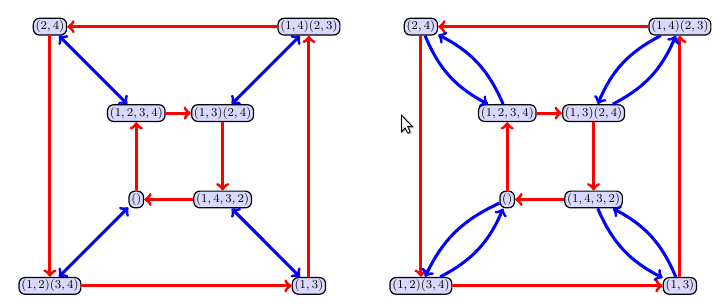Please Login to access more options.
Problem (Practice With Set Products)
Let $G$ be the group of automorphisms of the square, i.e. the dihedral group of order 8. Let $K=\{(),(1,4)(2.3)\}$, $L=\{(),(1,3)(2,4)\}$, and $M=\{(),(1,3)\}$.
- Compute the set products $KL$ and $LK$, and then $KM$ and $MK$, and then $LM$ and $ML$. For which products does $AB=BA$?
- Let $K=\{(),(1,4)(2,3)\}$ as before. Let $\alpha = (1,2)(3,4)$ and $\beta = (1,2,3,4)$. Consider the right cosets $A=K\alpha$ and $B=K\beta$. Is the set product $AB$ another right coset of $K$? Does $Ka=aK$ for each $a\in G$?
- Let $L=\{(),(1,3)(2,4)\}$ as before. Consider the right cosets $C=L\alpha$ and $D=L\beta$. Is the set product $CD$ another right coset of $L$? Does $La=aL$ for each $a\in G$?
- Let $M=\{(),(1,3)\}$ as before. Consider the right cosets $A=M\alpha$ and $B=M\beta$. Is the set product $AB$ another right coset of $M$? Does $Ma=aM$ for each $a\in G$?
Feel free to use the Cayley table on page 31, or the Cayley graph below, to do your computations.

Click to see a partial solution.
To compute $KL$, you just have to compute $$\begin{align} KL &= \{()\circ (), ()\circ (1,3)(2,4), (1,4)(2,3)\circ (), (1,4)(2,3)\circ (1,3)(2,4)\} \\ &= \{(), (1,3)(2,4), (1,4)(2,3), (1,2)(3,4)\}. \end{align}.$$ Similarly we just repeat the above in the reverse order to get $$\begin{align} LK &= \{()\circ (), ()\circ (1,4)(2,3), (1,3)(2,4)\circ (), (1,3)(2,4)\circ (1,4)(2,3)\} \\ &= \{(), (1,3)(2,4), (1,4)(2,3), (1,2)(3,4)\}. \end{align}.$$ This shows that $KL=LK$.
Repeat this for $KM$ and $MK$, and you should see that these two sets are not the same. In particular, one contains $(1,2,3,4)$ and the other contains $(1,4,3,2)$. When you do the computations for $LM$ and $ML$, you should find that $LM=ML$. If you noticed that $L$ consists of the identity and the 180 degree rotation, both of which commute with every element, this can make lots of your work really quickly when working with $L$. Any time you work with elements in the center of a group, set products are much simpler to work with.
Now we move on to the problems involving $\alpha$ and $\beta$. Direct computation gives $$\begin{align} K\alpha &= \{(1,2)(3,4), (1,4)(2,3)\circ (1,2)(3,4)\}=\{(1,2)(3,4),(1,3)(2,4)\}, \text{ and }\\ K\beta &= \{(1,2,3,4), (1,4)(2,3)\circ (1,2,3,4)\}=\{(1,2)(3,4),(1,3)\}.\\ \end{align}$$ We then compute the set product to be $$\begin{align} (K\alpha)(K\beta) &=\{(1,2)(3,4),(1,3)(2,4)\}\{(1,2)(3,4),(1,3)\}\\ &=\{(1,2)(3,4)\circ(1,2)(3,4),(1,2)(3,4)\circ(1,3),(1,3)(2,4)\circ(1,2)(3,4),(1,3)(2,4)\circ(1,3)\}\\ &=\{(2,4),(1,4,3,2),(1,4,3,2),(2,4)\}\\ &=\{(2,4),(1,4,3,2)\}.\\ \end{align}$$ This is precisely the coset $K(2,4)$, so we do have that $(K\alpha)(K\beta)$ is a coset. If you want to know even more, notice that $\alpha\circ \beta = (2.4)$, so we see that $(K\alpha)(K\beta)=K(\alpha\beta)$. To answer the question, "Does $Ka=aK$ for every $a\in G$, we just have to look at the 4 different right cosets of $K$ and compare them to the 4 different left cosets of $K$. Direct computation shows that $K\beta = \{(1,2,3,4),(1,3)\}$, whereas $\beta K = \{(1,2,3,4),(2,4)\}.$ This shows that $K$ is not normal.
If you repeat these computations with $L$, you should find that $(L\alpha)(L\beta)=L(\alpha\beta)$, and that $La=aL$ for every $a\in G$. If you recall that the rotation $R_{180}=(1,3)(2,4)$ is an element that commutes with every other element, then this part of the problem is really fast.
For the last part, you should find that $M\alpha=M\beta=\{\alpha, \beta\}$, but when you compute $(M\alpha)(M\beta)$, you obtain a set with 4 elements, namely $\{\alpha^2=(),\beta^2, \alpha\beta, \beta\alpha\}$. Since $\alpha\beta\neq \beta \alpha$, and $\beta^2$ does not equal any of the other elements, this set product consists of 4 elements. Because $|M|=2$, the set product $(M\alpha)(M\beta)$ cannot be a coset of $M$. This is because any coset of $M$ would have to have 2 elements as well, one of the properties of cosets.
The following pages link to this page.
